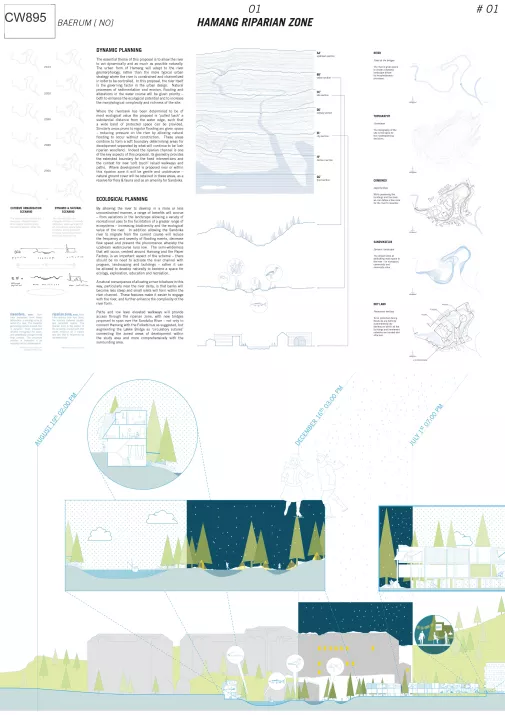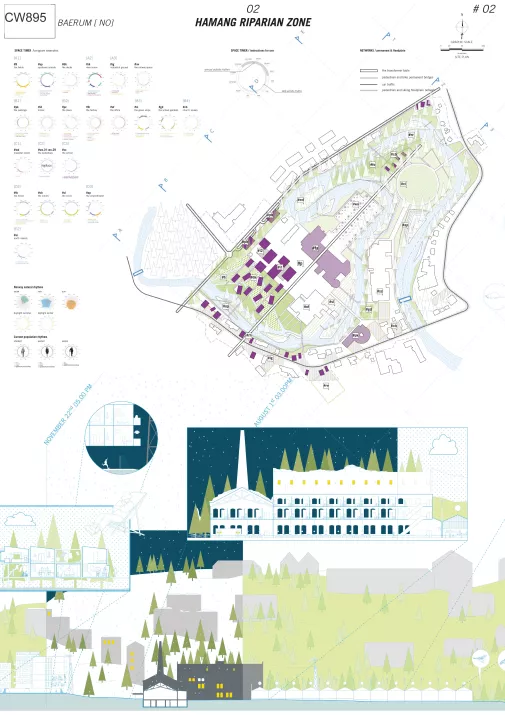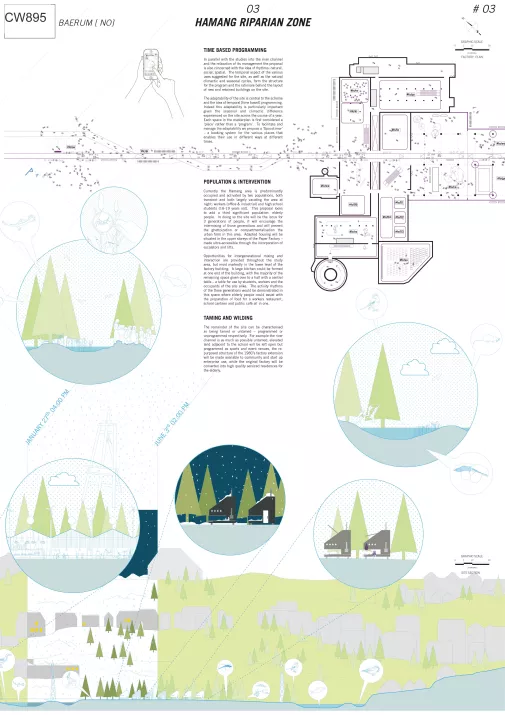Project:
Hamang Riparian Zone
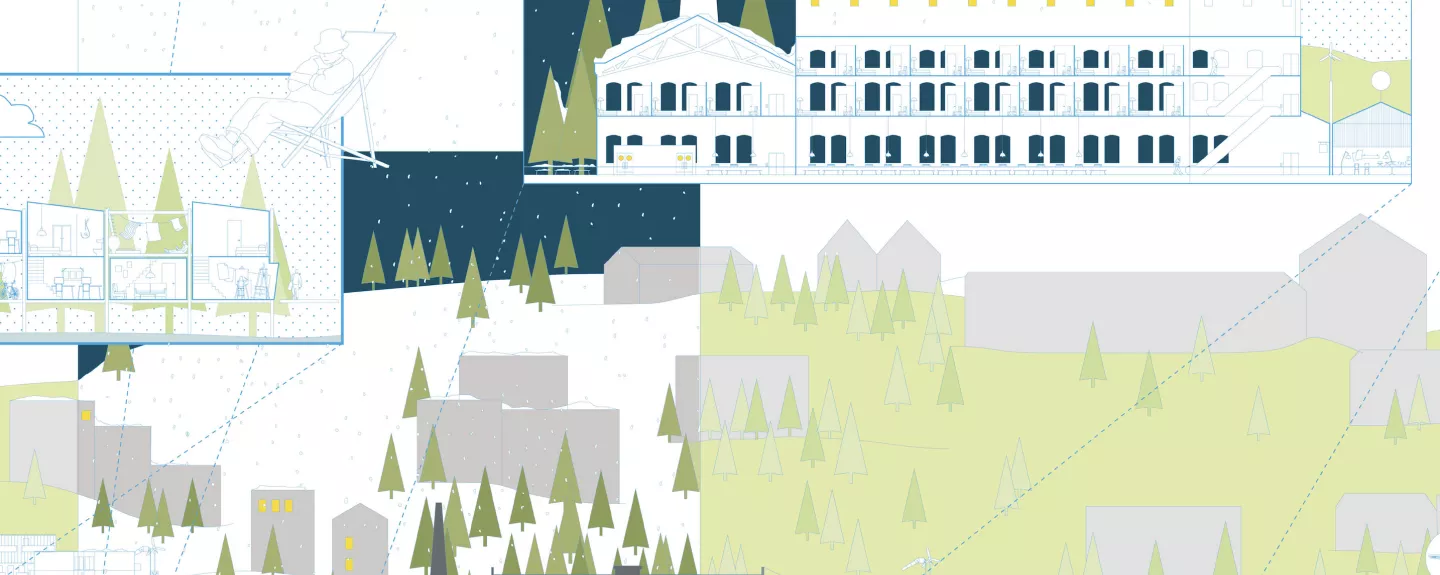
About
-
The essential theme of this proposal is to allow the river to act dynamically and as much as possible naturally. The urban form of Hamang will adapt to the river geomorphology, rather than the more typical urban strategy where the river is constrained and channelized in order to be controlled. In this proposal, the river itself is the governing factor in the urban design. Natural processes of sedimentation and erosion, flooding and alterations in the water course will be given priority – both to enhance the ecological potential and to increase the morphological complexity and richness of the site.
Where the riverbank has been determined to be of most ecological value the proposal is ‘pulled back’ a substantial distance from the water edge, such that a wide band of protected space can be provided. Similarly areas prone to regular flooding are given space – reducing pressure on the river by allowing natural flooding to occur without constriction. These areas combine to form a soft boundary determining areas for development separated by what will continue to be lush riparian woodland. Indeed the riparian channel is one of the key aspects of this proposal, its geometry provides the extended boundary for the fixed interventions and the context for new ‘soft touch’ raised walkways and paths. Where development is proposed near or within this riparian zone it will be gentle and unobtrusive – natural ground cover will be retained in these areas, as a reserve for flora & fauna and as an amenity for Sandvika.
By allowing the river to develop in a more or less unconstrained manner, a range of benefits will accrue – from variations in the landscape allowing a variety of recreational uses to the facilitation of a greater range of ecosystems – increasing biodiversity and the ecological value of the river. In addition allowing the Sandvika river to migrate from the current course will reduce the frequency and severity of flooding events, decrease flow speed and prevent the phenomenon whereby the upstream water-course runs low. The semi-wilderness that will occur, centred around Hamang and the Paper Factory, is an important aspect of the scheme – there should be no need to activate the river channel with program, landscaping and buildings – rather it can be allowed to develop naturally to become a space for ecology, exploration, education and recreation.
Paths and low level elevated walkways will provide access through the riparian zone, with new bridges proposed to span over the Sandvika River – not only to connect Hamang with the Folkets hus as suggested, but augmenting the Løkke Bridge as ‘circulatory sutures’ connecting the zoned areas of development within the study area and more comprehensively with the surrounding area.
-
The project situates the development of the site within the topographical and ecological context of the Sandviks River and its hydrological dynamics. The proposals not only addresses seasonal flooding but also the natural meandering that occurs naturally over time in case of a stream not being channelled. The project seeks to accommodate space for these future changes by giving space to the river and claims that it is this riparian system -including its specific and diverse flora and fauna developing over time- that defines the character of the site. In this reading of the site the project stands out. With compelling drawings, a narrative section that vividly depicts the programmes and detailed explorations of possible forms of inhabitation of the river zone evokes curiosity and stimulation.
Unfortunately the urgent challenges of density that Sandvika is facing in regards to its position within the region of Oslo and the question of connectivity to the city fabric and transportation system are not addressed. The distribution of volumes appears arbitrary and a cir- culation network, including distinct public and private spaces is not formulated.
However, in regards to the Europan topic of “Adaptable City“ the project offers an intriguing scheme, it expands the sub-theme of Eco-rhythms onto a time horizon that is usually not considered and opens a perspective on how natural flows and changes could inform a future urbanity.
Hamang is an extraordinary ecological site. The jury therefore recommends to take the strongest aspects of the project - the river’s changing life- into the further debate of the site’s development.
-
Adam Holicska
Ben Addy
Pauline Marcombe
Tim Murray
Vanessa LafoyCONTACT INFORMATION:
www.moxonarchitects.com
Related projects
-
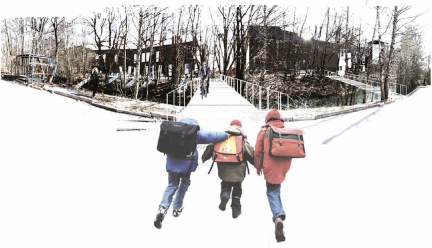
Social Riverscape
Built environment and nature come together, with a weave of green connections, establishing a new…
-

Hamang Riparian Zone
The urban form of Hamang will adapt to the river geomorphology, rather than the more typical urban…
-

Elasti-City
The main goal in this project is to bind together a rich but complex milieu: the different city…
